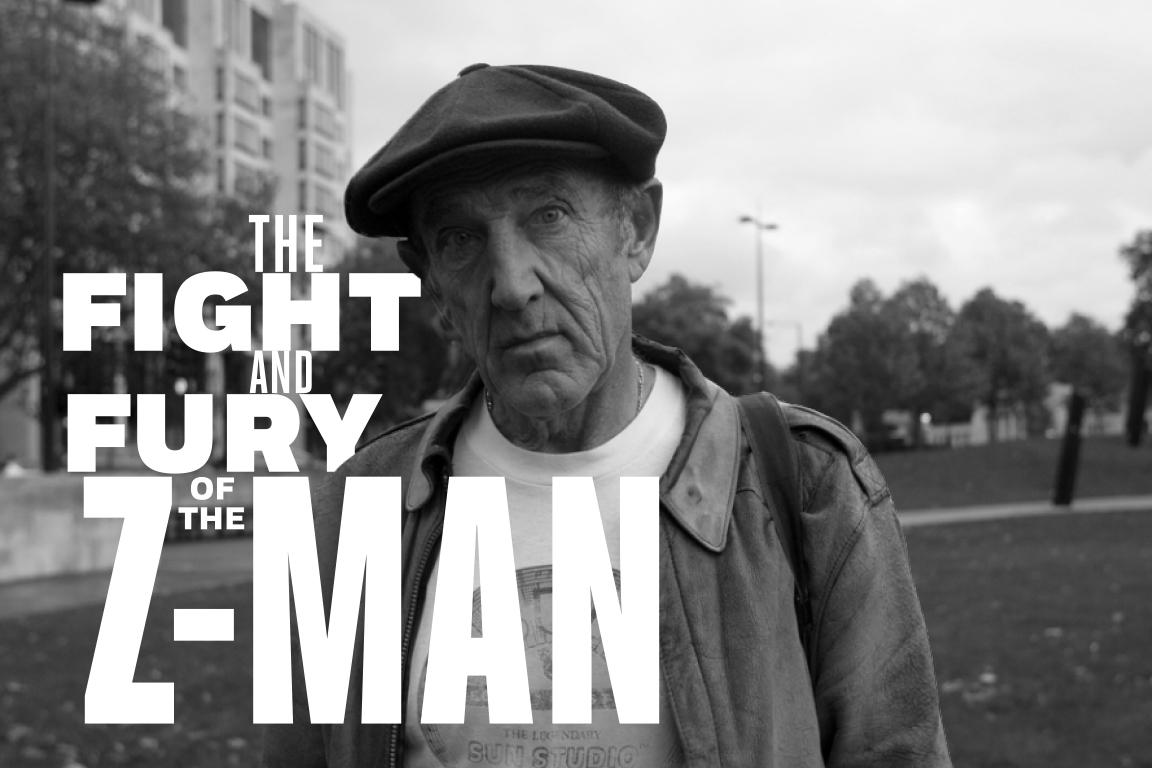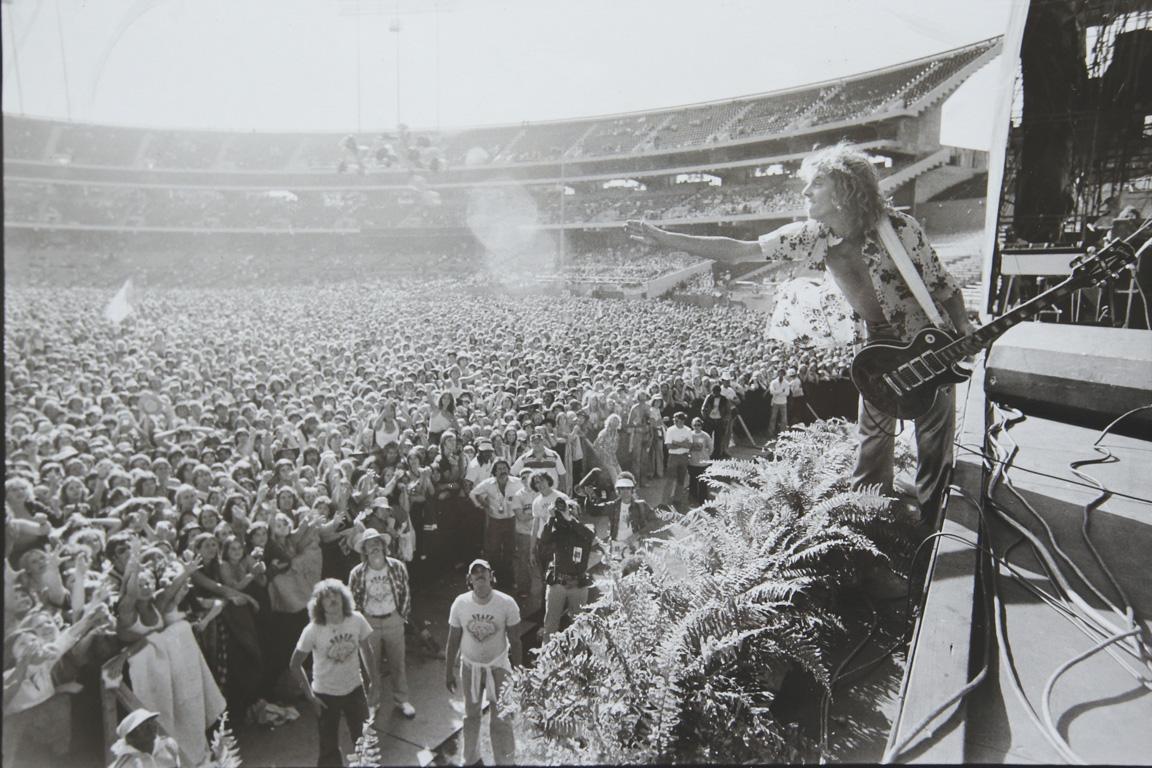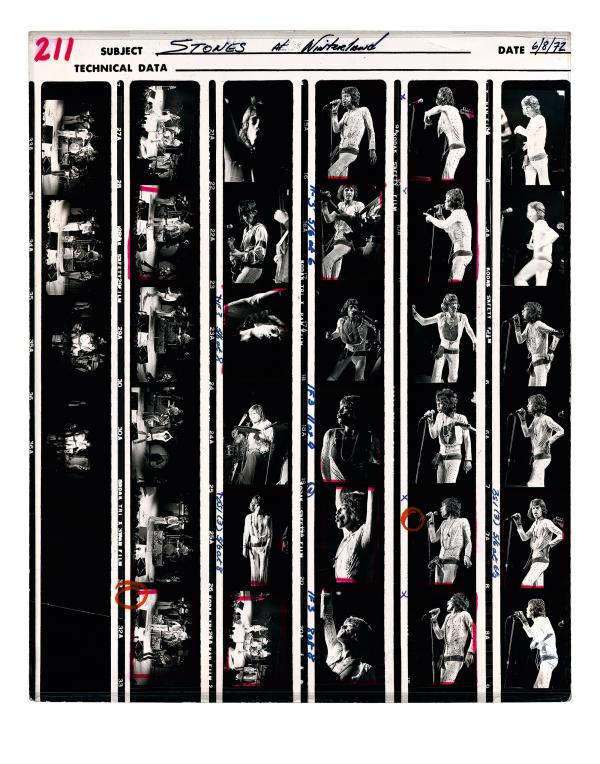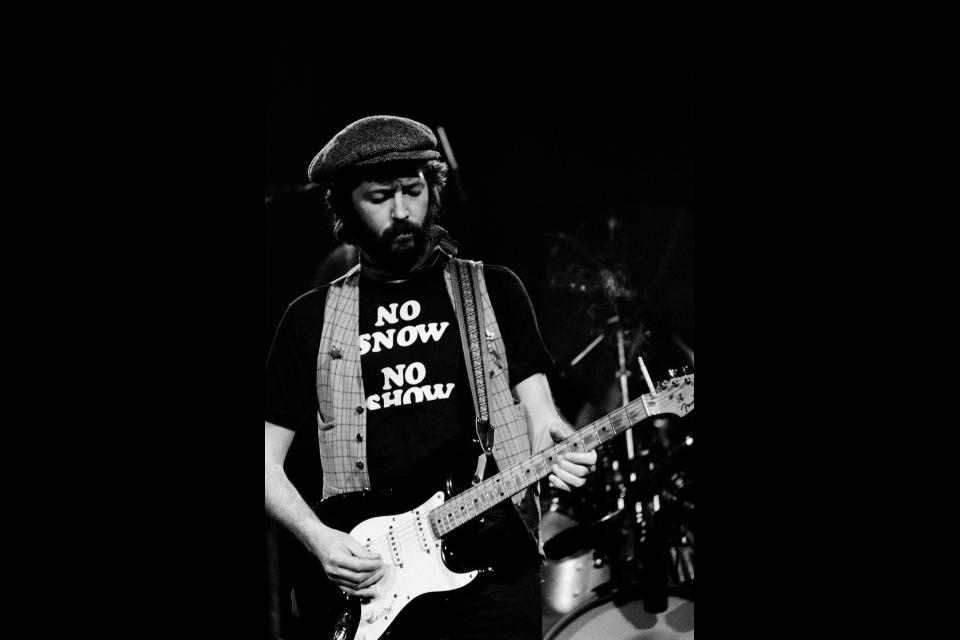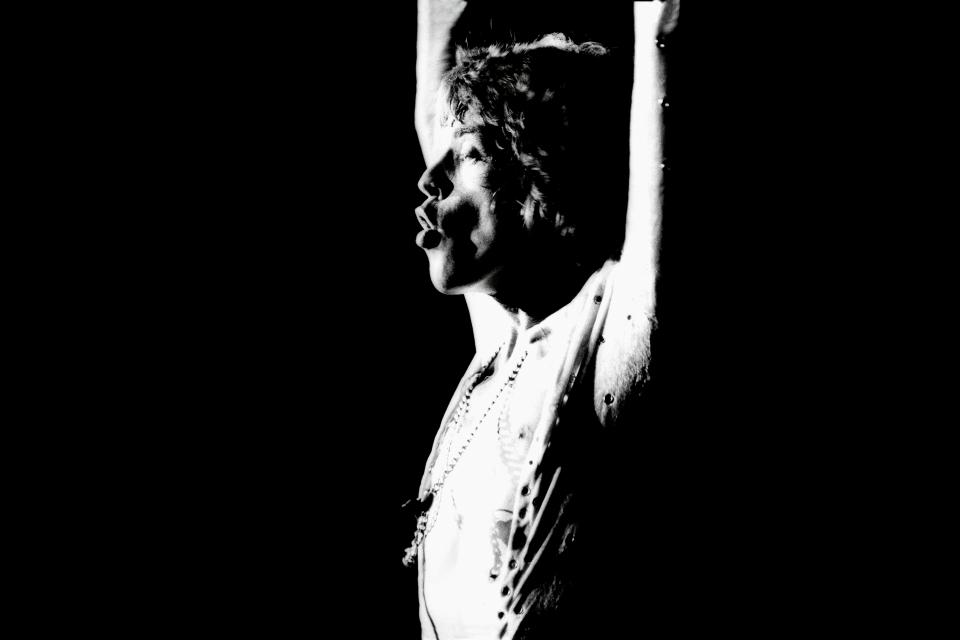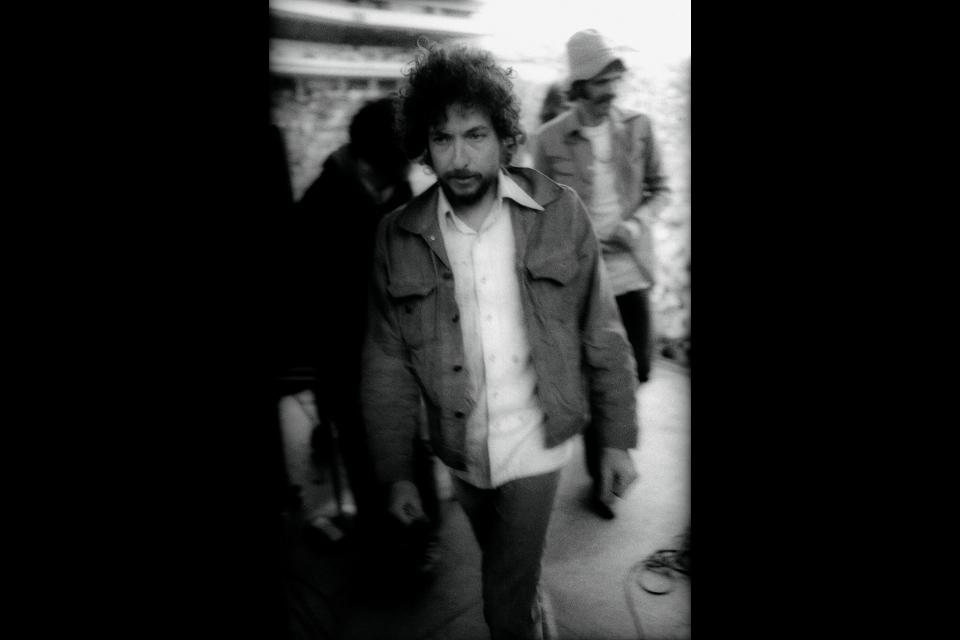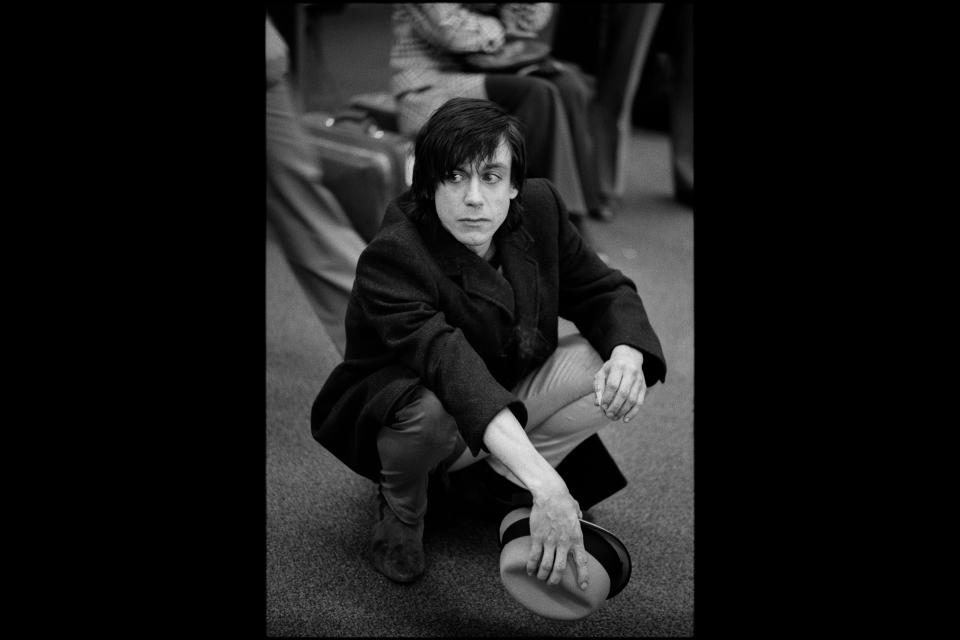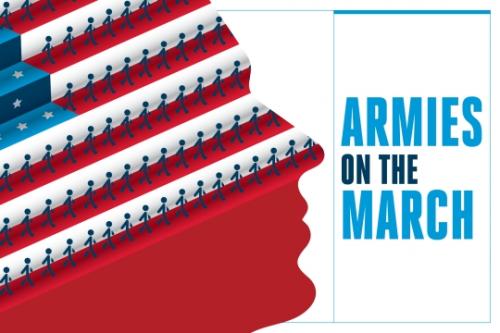The Fight and Fury of the Z-Man
Iconic photographer and eternal San Franciscan
Michael Zagaris, BA '67,
has shot rock gods and all-stars, stood up to The Man and almost died twice. He’s spent his life doing everything you always wanted to do, and now that he’s getting older ... absolutely nothing’s changed.
Story By Matthew Stoss
Photos by Michael Zagaris
Michael Zagaris is spry for a relic.
After hours in April, he moves through the Haight-Ashbury to a dark bar, equal parts fury and rock ’n’ roll.
He’s lived in this neighborhood—the once and future heart of free love and fighting The Man—since 1973. It’s where he’s celebrated and suffered psychedelia, onwarded and photographed the revolution, then watched the Winterland Ballroom shutter and the Grateful Dead move away.
Mr. Zagaris—photojournalist, romantic, polemicist—believes in magic, in an Eastern way, that it can be metabolized, misdirected and blocked but never destroyed. Right now, he says, it’s diminished, trampled under a Google bus and disrespected by the “tech yuppies” who gesso desecration over the city that he mourns and loves: San Francisco.
A grunt for Bobby Kennedy in ’68 and the official photographer for the 49ers since 1973 and the Oakland A’s since 1981, Mr. Zagaris, BA ’67, has spent his adulthood in San Francisco. He made himself and his old Nikon F fixtures in The Scene by haunting the city’s music venues—Winterland, the Boarding House, the Old Waldorf, the Family Dog, the Fillmore and Fillmore West.
He photographed Led Zeppelin’s last show in America and the Sex Pistols’ last show ever. He was a regular contributor for CREEM and Rolling Stone by the mid ’70s. He toured with The Who and the Rolling Stones and made friends with Keith Moon, Eric Clapton, George Harrison, Peter Frampton.
“He said, ‘Have you been to San Francis- co before?’” says Mr. Frampton, who met Mr. Zagaris in San Francisco in 1969 while on tour with Humble Pie. “And we said, ‘No,’ so the next thing you know, we sort of drifted off into sightseeing and we went all over. He was basically my first true friend that I made in the United States.”
Years later, Mr. Zagaris, as he often does with his celebrity friends, took Mr. Frampton to work with him,
inviting the rock star to a 49ers-Buccaneers game in Tampa Bay in 1986.
“I realized that I wasn’t going to be sitting in the stands,” says Mr. Frampton, who was living in Fort Lauderdale at the time. “I was his lens roadie.”
It was not lost on those in attendance that below them was Peter Frampton, running up and down the sideline, carrying some dude’s camera bag.
“People are shouting at me from the stands—‘Hey, Peter!’ It was funny.”
Mr. Zagaris is 71 years old, but except for his face, you wouldn’t know it. In the back of the dark bar, he chats up a waitress about community college, her ambition and her physics major before smoothing onto his soapbox—as essential to him as keys, phone and wallet—to tell her and everyone what’s become of the Haight, San Francisco and the human race.
These are his floating verses, his maverick stanzas.
“It’s why our species is endangered now,” Mr. Zagaris says, “because we’ve consumed— we’re all about consumption and we’re all about pillaging and taking what we want. So we’ve plundered most of the resources. There aren’t many spots left on the planet to invade, kill the natives that live there and take what we want, whether it’s oil from the ground or gold. So now we’re turning on each other, and I’m fighting that, too.”
Mr. Zagaris—Z-Man—has presence in his black leather jacket. He’s engaging, endearing, infuriating. He asks questions. He’ll talk to anyone. He’ll challenge anyone. He’s wiry, dense of form and with hands like they’ve done nothing but handle rope. He dyes his hair back to black. He has a commanding voice that flares during rants and, during stories, moves fluid between the English accents he perfected over decades of photographing and befriending the little island’s rock stars.
Z-Man is both a vestige of The Movement and a soldier for it. He’s always looking for the guy ruining it for the rest of us, and from his enemy, he draws sustenance and might.
“There’s always going to be something to be unhappy about,” Mr. Zagaris says. The leather jacket creaks when he moves. “I think most revolutionaries are like that. And whatever they’re fighting against, whatever they’re rebelling against, that is just grist for their mill. There’s always a deeper dissatisfaction and I’m not sure I know what that is but I know it’s there. And now the tech people, boy, they’re perfect for that. They’re all about what they have and they’re blind to everything else.”
He’s lived hard and slipped death twice but he’s rallied since 1983 and his last brush with the underworld. The Oakland A’s team doctor says he’s in great shape now, thanks in part to daily workouts at the JCC. Mr. Zagaris was raised Catholic. It’s all part of a life spent in search of the sweet spot between death and boredom.
“At some point, I’m going to fly too close to the sun and my wings will melt and it’s going to be a hard landing,” Mr. Zagaris says. “But you know what? Honestly? I don’t care. If that happened 10 seconds from now, I had a great ... run and a great time and I wouldn’t do anything differently.”
Z-MAN,
METHOD
PHOTOGRAPHER
Beneath the Oakland Coliseum, in the Oakland A’s clubhouse—basically a giant closet with a snack bar—Michael Zagaris and Sean Manaea are the only people around.
They’re both at Mr. Manaea’s locker before an April night game. A 6-foot-5, 245-pound affable slab of a left-hander, Mr. Manaea is in a swivel chair, half-uniformed and about two hours from making his major league debut. Mr. Zagaris, wearing an A’s hat and an A’s T-shirt, is squatting in front of the slab, which laughs frequently, and taking pictures. Neither of them gives even a half-damn about the camera.
When Mr. Zagaris is done with his photos, he stands up, pulls out his iPhone and shows Mr. Manaea a picture. They both laugh. Then Mr. Zagaris leaves Mr. Manaea to prepare, and Mr. Zagaris goes off to mingle with anyone else who might be breathing that night at the Coliseum—the clubhouse attendants, the security guard, A’s Executive Vice President of Baseball Operations Billy Beane, the other players, the opposing team.
When Mr. Zagaris takes a picture, he might as well be scratching his nose. Photography, at heart, is voyeurism, but his camera is less a peephole and more a barn door.
“The camera was an entrée into the scenes I wanted to live,” Mr. Zagaris says while driving around San Francisco one afternoon. He has a Kia that if it were an Autobot, would just transform into another Kia. “The camera allows you to do that, much like an actor can use the character or the role he’s playing to do that, to become that for a while.”
Meet Z-Man, method photographer.
This fall, Mr. Zagaris will release the first of three coffee-table books, which collect pictures and tales from his nearly 50 years as a professional photographer. During his career, he’s shot 38 Super Bowls and 12 World Series. He’s had Sports Illustrated covers, and NFL Films made a documentary about him in 2004. He’s done fashion, culture, life and—his favorite—music. The first book, Total Excess (Reel Art Press, October 2016), features his rock ’n’ roll work and the stories that, unless you’ve ever talked to him for more than 37 seconds, will be untold—like the time he says he tried to romance Nico in a famous Greenwich Village bar.
In the spring of 1967, Mr. Zagaris sat alone in Cafe Wha. Mr. Zagaris, then 21 and a senior at GW, was into The Velvet Underground and Nico, the album with the Andy Warhol banana on the cover and a striking picture of Nico, the German singer-songwriter and model, on the back.
“That picture—I was just transfixed,” Mr. Zagaris says. “I loved the way she looked and I wanted to meet her.”
He set out from D.C. in late March or early April.
“I would take the train from Union Station to Penn Station, and then I’d take the subway to Cafe Wha. And I’d sit at a table and I was writing poetry and I also remember I had a Turgenev book and I was also reading Hermann Hesse. And I’d wait and I must have done it five or six times—where you’re taking the train up to New York—and I’d sometimes sit there for three or four hours, and she didn’t come.”
But the last time …
“I was there for maybe an hour and, you know, I’d write a little and you’d have some coffee, maybe some tea, you’re reading, and all of a sudden, she walked in. I remember she went up and she sat down and she sat about three tables away and I sat for … half an hour, and then she got up and walked out. And I remember even at one point thinking should I get up and follow her and say, ‘Hey, excuse me, did you drop this?’ But I never did.”
Coward.
“I know.”
It was perhaps the last time Mr. Zagaris didn’t open his mouth.
The reason Mr. Zagaris’ work stands apart from that of other photographers of his time and genre is his ability to become whatever he’s shooting and be accepted by his subjects. That makes him more than the documenter of a story—he partied like a rock star and showered with the 49ers and routinely goes full Stanislavsky, wearing cleats to photograph games—it makes him a character.
“They brought him into their circle and allowed him to photograph them and hang out with them and party with them,” says David Talbot, the founder of Salon.com and a friend of Mr. Zagaris. “He was part of this revolution, this cultural revolution, and he was taking part in it and he was chronicling it at the same time. He was one of the fortunate few because it was a pretty rarefied circle to be hanging out with these amazing artists who were changing history, and he was allowed into their inner circle because, I’d say, of his large personality, because of his large heart and because of his intelligence and because of his creativity.”
Mr. Zagaris, of course, got the glamorous stage shots that make good dorm-room wallpaper and now sell for $1,000 a print on Wolfgang’s Vault and Rock Paper Photo, but his best stuff—his signature stuff—takes us backstage and into hotel rooms, to the spaces reserved for bands, roadies and favored groupies. A photo of Pete Townshend—The Who guitarist is seated with his back turned, meditating over a Les Paul and a Hiwatt amp—shows a quiet moment that no soul in an arena of 60,000 would have ever seen or stopped to think existed.
Mr. Zagaris pries for the moments that pass unobserved so he can show everyone else what he sees: rock stars and athletes as mortals. He proposes that we reassess our deifications and makes his argument with mood, atmosphere and the evincing use of natural light.
“He’s got great behind-the-scenes shots of me in the dressing room, tuning up and all that sort of stuff,” says Peter Frampton, who used a Zagaris photo for the Frampton Comes Alive! album cover. “That was his forte. He loved, of course, great live shots on stage, but he was always in the corner, and because he’s so personable and such a likeable person, he becomes part of the band for that night. So you don’t mind him being there. … You forget he’s got a camera and that is his secret and that’s why he got so many great shots. It is because it wasn’t like, ‘Oh God, there’s a photographer in the room.’ It wasn’t that at all. Never was. It was like, ‘We’ve got our friend, Mike, here.’”
Mr. Frampton has used Mr. Zagaris’ stuff since the early 1970s. Chris Isaak has used it since the early ’80s.
“I know a lot of guys who were photographers and hung around the rock scene and all they did is party and chase girls and stuff like that,” says Mr. Isaak, who’s also carried Mr. Zagaris’ camera bag. “And I have to say, Zagaris, for as much as it seems like he’s a partier and a wild man and all that stuff, I never saw him really do that. That wasn’t his thing. He wasn’t, like, trying to pick up girls with his camera. He wasn’t trying to party and get high. To me, it seemed like he really enjoyed the ballgame; he really enjoyed the music. He enjoyed the people—that was the number one thing. That shouldn’t seem odd but it made him stand out.”
Mr. Zagaris started hanging at rock shows in the late ’60s, conning and hustling to go where he wanted. As a teenager, he would drive (or get a ride, before he had his license) the 230 miles from his parents’ house in Redding, Calif., to San Francisco and flimflam his way onto the sidelines of old Kezar Stadium to shoot 49ers games, cozening the cops and posing as a press photographer. Mr. Zagaris sold the ruse with homemade counterfeit credentials, often spray-painted, that he modeled off the discarded press passes he found on the field after a game while he and his younger brother, Bruce Zagaris, BA ’69, JD ’72, LLM ’73, were collecting souvenir chinstraps.
The cops didn’t check the credentials up close.
“They would have seen that it was the wrong date or the wrong game,” says Bruce, now a partner and international law attorney at Berliner Corcoran & Rowe in Washington, D.C. “The ones that were spray-painted—they didn’t even have anything on them. They didn’t have any print on them. We would have been screwed if they had actually looked at them. But after a while, they kind of just look at the people, and once you’re on a couple of times and they see you, they just think you belong. They tend to look at the new people.”
One time when a cop challenged him, Michael Zagaris says, he told the officer that he was doing a book for the NFL—the completely-made-up-but-plausibly-named Sunday Gladiators—and stressed the importance of featuring in the book those who kept safe the field from hooligan raiders. The cops, he says, posed for a group photo and never hassled him again.
“What he’s always had is the ability to get access, partly because he’s extremely bold,” Bruce Zagaris says of his brother. “He will try things that nobody would even think of and succeed.”
At rock shows years later, Mr. Zagaris says, he’d sweet-talk his way backstage or feign legitimacy by telling whoever he needed to convince that he was writing a book about the influence of American blues on British musicians. Which he was. Detoured by photography, he never wrote it. The claim, though, apparently went unchallenged in an era of unbelievable access.
“He said to us that he was going to write a book, and so he said, ‘Could I interview you?’” Mr. Frampton says. “I hadn’t been interviewed that much as a member of Humble Pie at that point, so I said, ‘Yeah, why not? That’s fantastic. Let’s do it.’ … I didn’t think it was strange at all, to be honest.”
NPR rock ’n’ roll historian Ed Ward wrote for CREEM and Rolling Stone during the 1970s while he lived in Marin County, across the Golden Gate Bridge from San Francisco. He says scoring freelance assignments was easy then. Editors were amenable to new talent because there weren’t so many people vying for bylines.
“Once you had a name, people knew it,” Mr. Ward says. “So you could say, ‘Hi, I’d like to write about such and such, here’s a couple of clips,’ and they’d actually pay attention. Also, there were a lot more magazines, so if one turned you down, there were three or four more.”
Some were more stable than others.
“A lot of the rock magazines back then were real fly-by-night,” says Mr. Ward, the author of History of Rock & Roll Vol. 1 (Flatiron Books, November 2016). “They’d get going for a while, and then all of sudden, they wouldn’t pay people. And then all of a sudden, their phone would be disconnected. That happened a lot.”
Mr. Zagaris, working as an up-and-coming freelancer while paying his bills by teaching middle school in East Palo Alto, would approach the artists backstage and ambush them in the lobbies of their hotels. He says it was Eric Clapton, whom he met backstage in 1968 or ’69, who encouraged him to pursue photography as a career one night while hanging out in a San Francisco hotel room.
After a few years, Mr. Zagaris became a known entity, getting close to Winterland owner Bill Graham, the impresario and promoter who is widely considered to have invented the modern rock show.
Never shy and inspired by the musicians he spent so much time around, Mr. Zagaris hustled well. To make it on the West Coast leg of the now-infamous 1972 Rolling Stones tour—it was in support of Exile On Main St.—he says he lied about being a Vogue photographer, impersonating Leo Lerman, the magazine’s legendary editor, in a phone call to the Stones’ lead flack.
Scamming, Mr. Zagaris says, was the industry standard and everyone got ripped off. One famous band, he says, didn’t like to pay anyone—caterer, limo driver, photographer—because they believed the experience of working for them was more valuable than money.
“These people, they’re all predatory,” Mr. Zagaris says. “So I don’t feel bad about any of this. I was hustling to get on to do something. I loved the way they were hustling to establish themselves and their career.”
Mr. Isaak, who met Mr. Zagaris shortly after moving to San Francisco from Stockton, Calif., in the late 1970s, says he did similar things while trying to establish himself, years before he broke out with the song “Wicked Game” in 1989.
“I used to go into shows when I was broke,” says Mr. Isaak, who babysat Mr. Zagaris’ son, Ari, BA ’00. “And I’d walk in dressed to the nines in my stage clothes, with my guitar in a case, and I’d just walk in and people would just go, ‘Well, he’s obviously a musician. He’s got his hair all combed, he’s wearing a suit and he’s got a guitar in a case,’ and I’d stand for the whole damn show with my guitar and listen to the music ’cause I didn’t have five bucks. I think if you love it, you find a way in.”
Mr. Zagaris used amiable guile and the Nikon F.
By strict definition, Mr. Zagaris is not a rock star. He hasn’t mastered any combination of three chords and, at this point, probably couldn’t pull off a Freddie Mercury unitard, but being a rock star isn’t just about repurposed blues riffs, 4-4 time and a Bedazzled onesie. It’s about attitude and aura and maybe a camera, and that, with proper inspiration, is sometimes all you need.
IDOL WILD
Michael Zagaris, again in the black leather jacket and matching baseball cap, is snug into the couch of his roomy three-bedroom, two-bath Haight-Ashbury apartment. The rent is about half of what it should be, which is the reason Mr. Zagaris, admittedly not a businessman, can afford to live there. He won’t leave the Haight until he’s out of last resorts. Photographing rock and roll, he says, isn’t a road to a Tesla, beachfront real estate and a golden toilet seat. On tour with The Who in 1973, Mr. Zagaris says, he subsisted mostly by scavenging room service trays in hotels while his net worth hovered around $47.
The photo archive that fills two rooms in his apartment might be worth… something. Too bad it’s a buyer’s market.
Steady employment by the 49ers and later the A’s bankrolled Mr. Zagaris’ rock habit, and it still bankrolls him today, years after he’s retired to his equivalent of a rusticating life that’s paid for month-to-month. Across a coffee table and among ceiling-high bookshelves in an open-concept living room is the flatscreen TV. CNN is going hot and the punditry is pits deep in the Republican primary.
Mr. Zagaris, noticing, stops a soliloquy on capitalism, Vietnam and how Allen Dulles, LLB ’26, killed JFK to charge punk-rock seething into a not-unrelated tangent about the state of U.S. politics.
“The real gods in this country? It’s celebrities, and that’s as empty as it gets,” Mr. Zagaris says. “That’s why we’re where we’re at and we’re kind of lost as a nation, and these are our choices? And nothing against Bernie [Sanders], but all the others, I’m thinking for the supposed most powerful country in the world… I mean, talk about the clown car. This is actually an affront to the clown car.”
And the buyer’s market? That stinks, he says, but it’s not about that.
“I think any artist, whether you’re a writer or you’re a painter or you’re a filmmaker or you’re a dancer, you’re trying to express yourself in the culture,” Mr. Zagaris says. “And that becomes paramount to you rather than just, ‘I have a job to make money.’ I’m not putting anybody down that does that. I mean, most of the world has to do it. I’m not saying that’s wrong—it would be wrong for me, and you try to follow your calling.”
Classic Z-Man.
The apartment he shares with his longtime girlfriend, model Kristin Sundbom, is as much a shrine to his idols as it is a residence. Prints of his photos are on the walls—Patti Smith in one bathroom, Rick James and Lou Reed in another, Jimmy Page outside the kitchen—and rock star action figures decorate the bookshelves, which house a rather large personal library, of which Chris Isaak read liberally during his early San Francisco days.
Mr. Zagaris has always been drawn to rebels, iconoclasts and those keen to fight the misfeasance of our overlords. First, these were movie stars like Marlon Brando and James Dean and musicians like Chuck Berry, whom Mr. Zagaris, attending his first concert, saw live at the Stockton Civic Auditorium in 1956. It was anyone dynamic, flamboyant and cool—anyone with energy and magic. That later included political figures, specifically John F. Kennedy, and Mr. Zagaris shifted the focus of his idol worship to those in traditional channels.
In college, Mr. Zagaris worked as a “glorified page” for California Sen. Pierre Salinger, for whom Mr. Zagaris’ father, a progressive Democrat and the son of Greek immigrants, had done fundraising in Northern California. By 1965, with the help of Mr. Salinger, Mr. Zagaris got a job on Robert Kennedy’s staff, answering mail and clipping newspaper articles, and once, Mr. Zagaris says, loaning the then-New York senator a few dollars for a cab ride.
“Bobby never had any money,” Mr. Zagaris says.
By February 1968, Mr. Zagaris was traveling with Mr. Kennedy as part of the senator’s campaign for the Democratic presidential nomination. That’s how Mr. Zagaris ended up in the Ambassador Hotel in Los Angeles on June 4, 1968. It was crowded and equatorially hot. He thought someone set off firecrackers.
“He’s been shaped by a lot of different things,” says Ari Zagaris, Mr. Zagaris’ 39-year-old son, an actor and former minor league pitcher who had a small role in Moneyball. “Before he was at GW… he was a much different person. He wanted to be an NFL football player, he wanted to be a senator and then he wanted to be president. Then he was probably a couple hundred feet behind Bobby when he [got shot], and that blew his mind.”
On June 6, Mr. Zagaris flew to San Francisco from Los Angeles. While he was driving home to San Jose, he heard on the radio that Bobby Kennedy had died.
“I had to pull over,” Mr. Zagaris says,” and I started crying.”
That was it, the moment he abandoned traditional leaders and sought his idols elsewhere. Frustrated and furious at America’s habit of murdering its leaders—Martin Luther King Jr. was assassinated that April, preceded by Malcolm X in ’65 and JFK in ’63—he ran to the counterculture.
“All this stuff I had been taught by parents,” Mr. Zagaris says, “by the Jesuits, all this well-meaning stuff—basically ‘be good, do the right thing, study hard to get good grades, make your parents and family and community proud, marry a beautiful girl, have a nice house and a big car and be a success…’ When you kill the ideals of your childhood, you’re in deep, deep trouble.”
He flunked out of law school at Santa Clara University in nuclear fashion, screeding through several Bluebooks during a contracts final with aggressively impolite language on how and why America was totally hosed. A month later, he was classified 1A by the draft board. (A childhood illness, he says, later got that changed to 1Y, and he never went to Vietnam.)
Finally, Mr. Zagaris, disillusioned, moved to San Francisco.
THE CITY
HE MOURNS AND LOVES
Down a hill from Chris Isaak’s house on a ridge and spread before a Golden Gate Bridge vista is a girl dancing on the beach. She’s been to school for dancing and so have her friends, who have their smartphones aimed dead red at her while she makes art from motion. It’s late afternoon, the sky is one big lens flare and an intrigued Michael Zagaris stops to ask her questions.
They agree that it’s hard to be an artist in San Francisco right now. All parties, of course, blame the techies—those new Visigoths, the invaders who stand heretical to all that is good and holy here—for pushing rent for a studio to $3,000 a month and driving out bohemia at the blunted tip of a tablet stylus.
And yet, Mr. Zagaris and the beach dancers have hope.
“San Francisco, like New Orleans or like Paris or Amsterdam, has its own energy,” Mr. Zagaris says. “You might hear about it, but when you get there, you can sense it. You can feel it.”
To Mr. Zagaris, San Francisco sits on ley lines that are out of use and decommissioned everywhere but a few cities. It’s a nexus, a point of energy convergence—although the reason why has less to do with mysticism and more to do with the outlaws, outcasts and misfits who settled the city, starting with the gold rush in the 1840s.
“There was this feeling that you couldn’t go any further,” says David Talbot, who authored a history of San Francisco called Season of the Witch and has lived in the city since 1981. “A lot of people who went for the gold rush were there because they were losers, they were on the run from the law and this was their last chance to strike it rich, and [the city] still has that sensibility, certainly with the tech revolution. People have made that comparison—that there are still people coming out west to San Francisco and Silicon Valley to try to get their payday.”
Traditionalists have periodically challenged San Francisco’s entrenched libertine attitudes but they’ve won little or nothing, and today, Mr. Talbot says, the city remains an “open and tolerant society.” It’s a fact that helps the city assimilate the waves of outsiders who inevitably immigrate here. San Francisco is still working, albeit with a certain hostility, to absorb the techies.
In the early part of the 20th century, Catholic immigrants fought the anything-goes-as-long-as-you-don’t-set-anything-on-fire mentality. Later, they fought the arrivals of the Beats, hippies and gays. But even those Catholics and other traditionalists, Mr. Talbot says, were politically progressive, which made compromise easier and victory possible for all the weird people. Mr. Talbot says San Francisco is, in many ways, the “first liberated city,” and in that is the allure that drew Mr. Zagaris, one among those weird, in 1973 and created and sustained an arts-and-culture singularity that went supermassive after the summer of ’67.
Peter Frampton chose to record Frampton Comes Alive! there, at the Winterland Ballroom, because of San Francisco’s “open and uninhibited” audience. Chris Isaak just says that San Francisco is the place you go to “do your art.” L.A., that’s for business.
All of it—the history, the politics, the people—coalesced to create a place like no other, one Mr. Zagaris—Z-Man—rages to protect and maintain. He is a phantom from an elapsed epoch, too limber to be a fossil and too vital to fade away. Despite ungodly prices and those despised interlopers, he stays in the Haight, where he won’t change and he continues to fight those who aren’t keeping it hip for the rest of us.
It’s obvious to Z-Man that he isn’t winning, but this isn’t about winning. It’s about the fight.
“Unlike a lot of people who stayed for a while, lost their hair, got a job and got it together,” Ari Zagaris says, “he continued to ... hold the torch and let his flag fly and still live in the Haight and hasn’t written a check since 1968, so there’s no paper trail.
“He’s always fought and he continues to fight, and I think as long as he keeps his sword up—that keeps him young and that keeps him who he is. A lot of other people, as they get older, I think they get more conservative and they start to pull back a little, and I think he’s very reticent about letting that happen to him. … I think he wants to continue to bash through walls until his body won’t let him.”
Other Summer Features:
Armies on the March
The ups and downs of a presidential campaign and the army of GW alumni along for the ride
Fasting for Love
When the flame of an old tradition gets snuffed out, should it be rekindled—or reengineered?
'Google Maps' of the Miniscule
A new imaging facility brings the nanometer and atomic worlds into focus.


